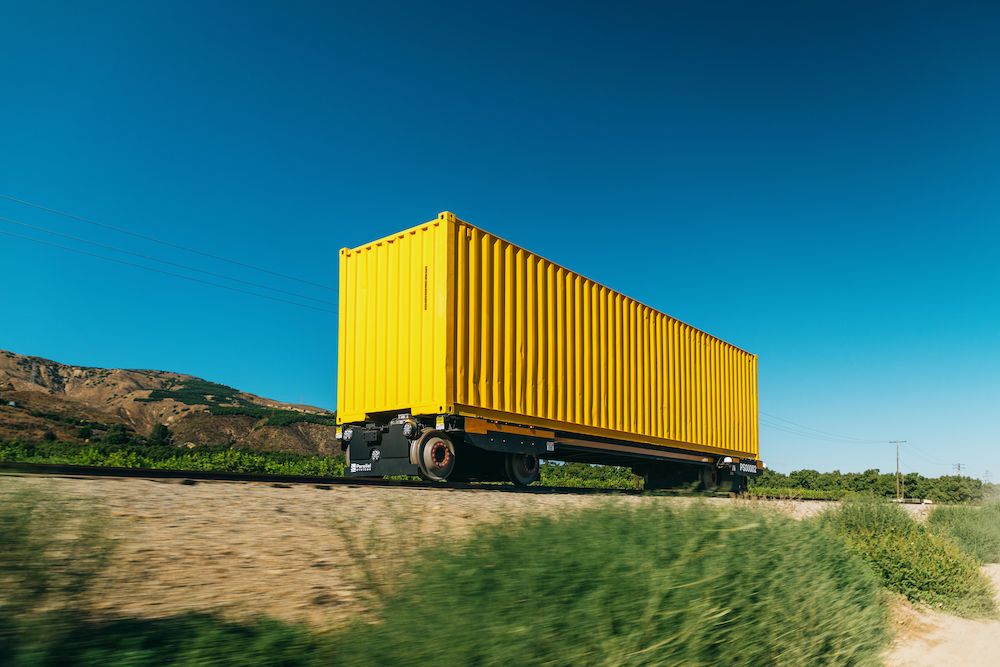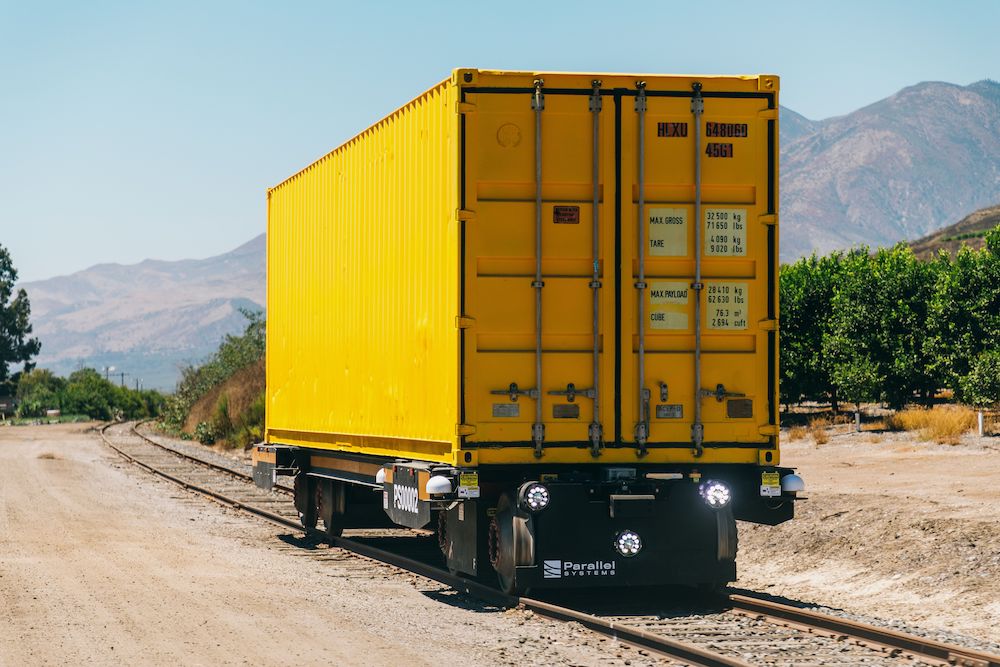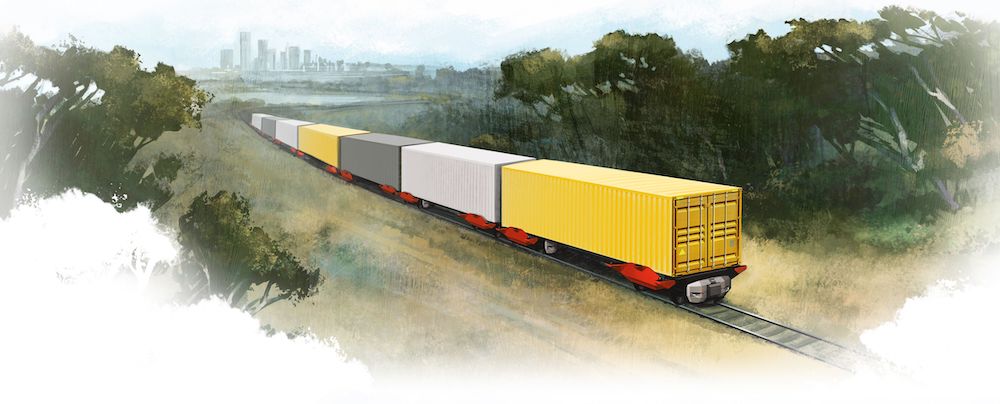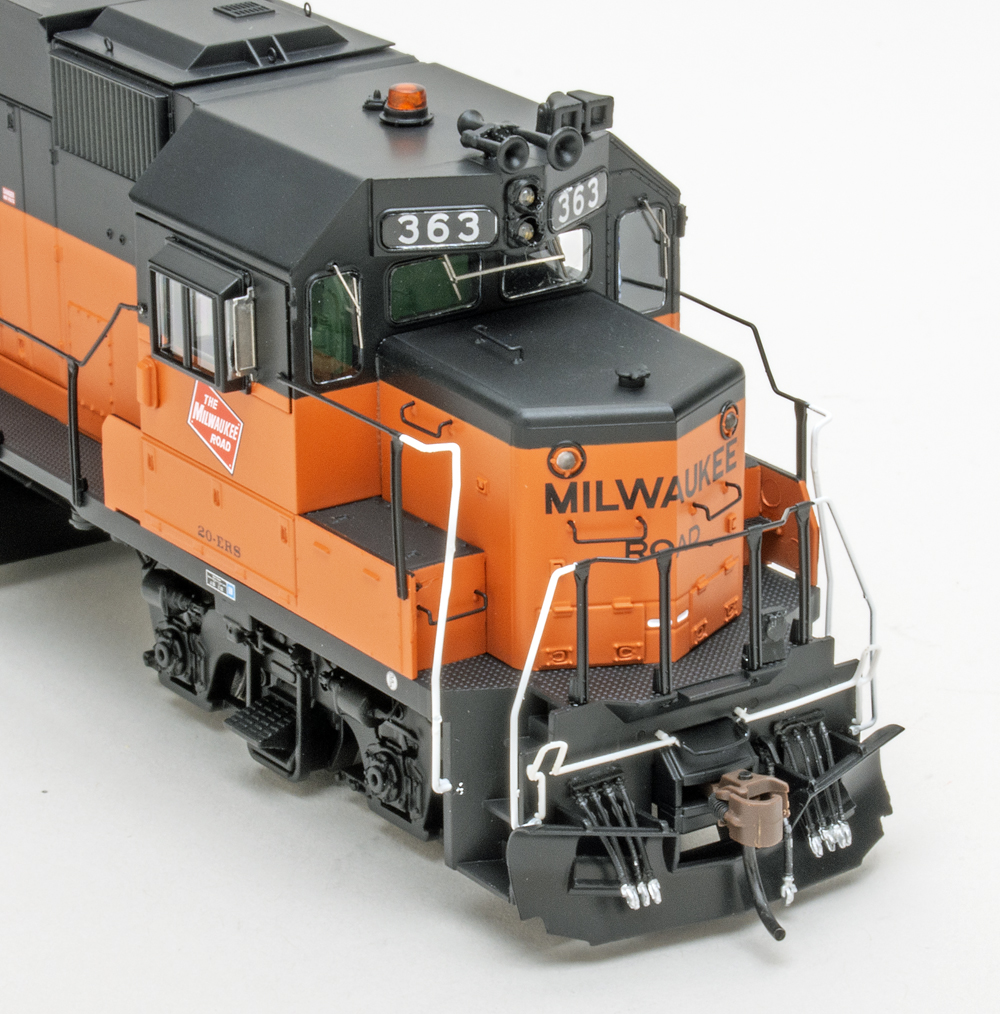
LOS ANGELES – Parallel Systems today introduced its second generation battery-electric autonomous container car system, which the company hopes will see pilot testing on Genesee & Wyoming short lines in Georgia as well as with international customers.
Parallel says the new prototype is undergoing testing to verify the system’s ability to operate on the conventional rail network. The goal, Parallel says, is to allow railroads to operate Parallel vehicles using existing train dispatching and control systems.
“Testing this vehicle generation and supporting systems is a critical step in our product development to inform our commercial product,” Parallel co-founder and CEO Matt Soule said in a statement. “With less than 3% of the 143,000 miles of U.S. railway occupied by active trains at any given moment, there’s immense opportunity to shift freight from the overburdened trucking industry to rail. In addition to addressing the truck driver shortage, converting 100,000 trucking miles to Parallel’s rail zero-emissions vehicles would eliminate up to 175 tons of carbon dioxide from the atmosphere.”

The second generation vehicle includes both autonomous and remote operation features. While initial pilot tests will operate under supervision at all times, the autonomous system will be installed, learning and improving as Parallel further develops its autonomous capability, Parallel said.
Parallel Systems has produced three second generation vehicles, with three more in production and more expected to follow. The vehicles have been undergoing control, telemetry, traction, brake and dynamics testing since November 2022 on Parallel’s Southern California test track. Track-worthiness testing will be conducted with MxV Rail in Pueblo, Colo., next year.
Each Parallel railcar is individually powered and can form platoons of up to 50 cars to reduce energy consumption and efficiently use rail network capacity. The platooning is fully automated: the railcars don’t need to couple or uncouple. They simply move close to each other and then initiate contact through bumpers to form platoons. Once contact is made, each vehicle maintains a set force with the one in front by regulating tractive effort. The small air gap and pushing action through railcar bumpers reduces overall aerodynamic drag of the platoon, improving energy efficiency.

The company says the vehicles will have a range of 500 miles and will be able to recharge in as little as an hour.
Parallel’s second generation vehicle is being built to the following specifications:
- Propulsion system: Battery-electric traction motor powertrain.
- Autonomous system: Fully autonomous, with bi-directional camera-based perception system.
- Payload capacity: Up to 70,000 pounds with a single stack container.
Last month Parallel and G&W short lines Heart of Georgia and Georgia Central sought Federal Railroad Administration approval to conduct a pilot program as early as next year.
Parallel was founded in 2020 by a group of former SpaceX engineers who aim to develop systems to move freight cleaner, faster, safer, and more cost effectively than traditional trains or trucks.














I said it before and I keep on saying it – “Enjoy all the limited capacity of a truck with none of the annoying flexibility of the nationwide highway system.”
If anyone remembers John J. Kneiling’s columns from Trains back in the 60s and 70s, he was visualizing systems like this. He always suggested that technology would take us to a point where human labor would be minimized, and now here we are. That was back in the days of 5-man crews, and lately UP is working toward one-man operations. His views weren’t particularly popular back then.
The concept of “platooning” of course suggests autonomous trains, without actual locomotives. But I think we (and Parallel Systems) may still be quite a ways off from perfecting that concept. And they will have to also figure out a way to construct the infrastructure to recharge multiple cars automatically. Or hire a bunch of people to plug them in one at a time.
Mr. Shapp, apparently you may be knowledgeable in something about the USRRB that I’m not aware of. I always assumed outside contractors paid into Social Security. Any links?
Mr. Shapp, apparently you may be knowledgeable in something about the USRRB that I’m not aware of. I always assumed outside contractors paid into Social Security. Any links?
I may stand corrected, as I did some research, and apparently there is some info about certain outside contractors in the USRRB that I wasn’t aware of: Chapter 02: Employer Coverage Status
They are not zero emissions. They have to get energy from somewhere. Solar has emissions when making the panels. Batteries have emissions when mined and manufacturered. Even horses have emissions. Low emissions yes. Not zero
What’s to keep someone from obstructing the track and hijacking its contents.
Agreed. CA 1969, I briefly worked for ~ 2 years in the E-L Rwy PD headquartered in Hoboken, NJ, before transferring to the E-L telco dept in 1970. During that 2 year period, I was made aware of gangs of kids raiding long and slow (~5MPH) interchange drags along the bottom edge of the Palisades, parallel to the Hudson River, from the PC interchange at Weehawken to our E-L sorting yard at Jersey City. The kids knew how to isolate the freight in the middle by shutting off the air cock and pulling the coupler rod to cut the train in half. And at 5MPH, the engineer never reaized what was going on. Then the kids would loot out a reefer car and bring the frozen foods to some various mom & pop grocery stores for the money. So I can easily imagine these P.S.’s AI cars being raided, highjacked, and looted.
Modern security technologies (cameras and other detectors) can do a pretty good job alerting authorities to trouble. Also, I expect to see drones patrolling particularly trouble-prone areas.
This should scare the crap out of every active and retired railroader. The only thing motivating these techies at Parallel Systems is their belief that they can get filthy rich convincing railroad managers that adoption of these cars will enable them to put all their freight conductors and engineer out of work.
Agreed, as P.S. employees do not pay into USRRB.
It’s impressive. We’ll see how the tests go.
Mr. Hammer: Do I understand you to say active contract employees do not pay into Railroad Retirement? That’s just wrong.